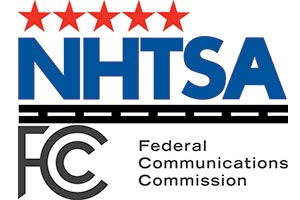Connected-Vehicle Spectrum Fight Intensifies

This story appears in the Sept. 19 print edition of Transport Topics.
A battle within the business world is growing over the use of a slice of the radio frequency spectrum. It pits vehicle manufacturers and their allies against Wi-Fi providers, often owned by telecommunications companies.
The contest for spectrum space also matches the Federal Communications Commission against the National Highway Traffic Safety Administration. The coveted prize is the range of 5.85 to 5.925 gigahertz, or GHz, the reserved home of dedicated short-range communications, or DSRC. This is the foundation of connecting vehicles with transportation infrastructure, other vehicles and even pedestrians.
The 5.9 GHz portion of the spectrum has been reserved for DSRC by the FCC since 1999, but it has been lightly used. It is close to the heavily used Wi-Fi band around 5.8 GHz.
Wi-Fi providers want to share the space with transportation.
“The issue is whether they can co-exist,” said transportation technology consultant Richard Bishop.
“For vehicle-to-vehicle and vehicle-to-infrastructure communications, this spectrum is really essential,” said Bishop, who worked on connected trucks and cars for the Federal Highway Administration in the 1990s.
“The Wi-Fi industry has seized on DSRC delays as an opportunity to expand their spectrum, and they’ve gotten some pretty powerful fans,” said attorney Laura Stefani of Fletcher, Heald & Hildreth.
Stefani’s fan reference is to three of the five FCC commissioners who have filed public statements in support of examining how to share the 5.9 GHz band between DSRC and Wi-Fi.
“We believe this slice of spectrum provides the best near-term opportunity for promoting innovation and expanding current offerings, such as Wi-Fi,” Commissioners Michael O’Rielly and Jessica Rosenworcel wrote in a joint statement.
“This spectrum is tailor-made for the next generation of high-speed, wireless broadband,” Commissioner Ajit Pai said in his statement.
The FCC solicited comments on sharing the DSRC spectrum through July 22 and received more than 650 major comments on the subject.
Communications attorney Stefani said she expects FCC will work on developing testing procedures at least through the end of this year.
“They will work on ideas for some kind of joint testing, with all kinds of back and forth in play on how to test,” she said. “It could take anywhere from six months to two years for an actual order” from FCC.
NHTSA started work on a mandate for connected cars and other light vehicles in 2014, and in January, the agency sent its version of a proposed connected-vehicle rule to the White House Office of Management and Budget for review, where it has languished since.
The agency wants to start with a mandate on new cars, as that is the quickest way to get lots of connected vehicles on the roads. However, in March, NHTSA engineer Alrik Svenson said at a trucking meeting that, while a timeline for a heavy-truck regulation doesn’t exist, NHTSA is studying V2V and large trucks.
American Trucking Associations filed comments and urged thorough testing before ceding any of the spectrum to nontransportation uses.
“ATA wants the FCC to know that ATA’s membership supports the need to maintain a dedicated bandwidth … within the 5.9 GHz frequency spectrum for the Connected Vehicle Program and other highway safety applications, until such time as it can be shown that sharing the band will not degrade connected vehicle communications,” said Ted Scott, the federation’s director of engineering services.
Despite the light usage since 1999, Scott pointed to several indicators that change could come soon. In addition to the NHTSA proposal, General Motors Co. said its 2017 model-year Cadillac CTS vehicles will be con- nected, and Peloton Technology has said it aims to launch a platooning system with DSRC for trucks in 2017.
Intelligent Transportation Society of America, or ITS America, helped land the 1999 spectrum dedication and strongly opposes encroachment by nontransportation firms.
“DSRC can save lives, prevent injuries and improve first-responder capabilities,” ITS said in its comments.
“DSRC requires the full … allocation for deployment; it cannot be picked apart with arbitrary judgments about what will not affect the efficacy of DSRC systems,” the society added.
Deborah Hersman, president of the National Safety Council and a former chairman of the National Transportation Safety Board, also backed the use of DSRC.
“Any sharing protocol must work around DSRC applications, and thorough testing must be done to determine that the protocol is safe before sharing is allowed,” Hersman wrote.
“The most important contribution of this technology is its potential to greatly reduce the number of fatal crashes on our roadways. DSRC- enabled vehicles are an important part of this goal,” she added.
In contrast, the Wi-Fi Alliance wrote, “There is broad agreement in the record that there is a need for additional spectrum capacity … and the [5.9 GHz] band, in particular, is well-suited for providing that additional capacity. Wi-Fi Alliance therefore urges the Commission to move quickly in concluding its tests and deciding how best to promote sharing in the band, so that the Wi-Fi industry and Wi-Fi users can soon unlock the band’s full potential.”
Microsoft Corp. offered a description of the current status of its industry as part of its comments. The company said it supports sharing DSRC’s spectrum and that its cloud-computing operates at 2.4 GHz and above, and Wi-Fi at around 5 GHz.
“The 2.4 GHz band is congested, and even the additional spectrum in the 5 GHz bands is becoming saturated at certain times and places as the demand for mobile data grows unabated. Wi-Fi expansion into the 5.9 GHz band would add necessary additional spectrum,” the technology giant said.
Microsoft also said efforts are under way to connect vehicles to the transportation infrastructure and each other via the cloud.




